Is Harvard Destroying Allston—or Saving It?
As Harvard unfolds shiny new development projects for the future of Allston Rock City, does that mean the party’s over, or is it just getting started?
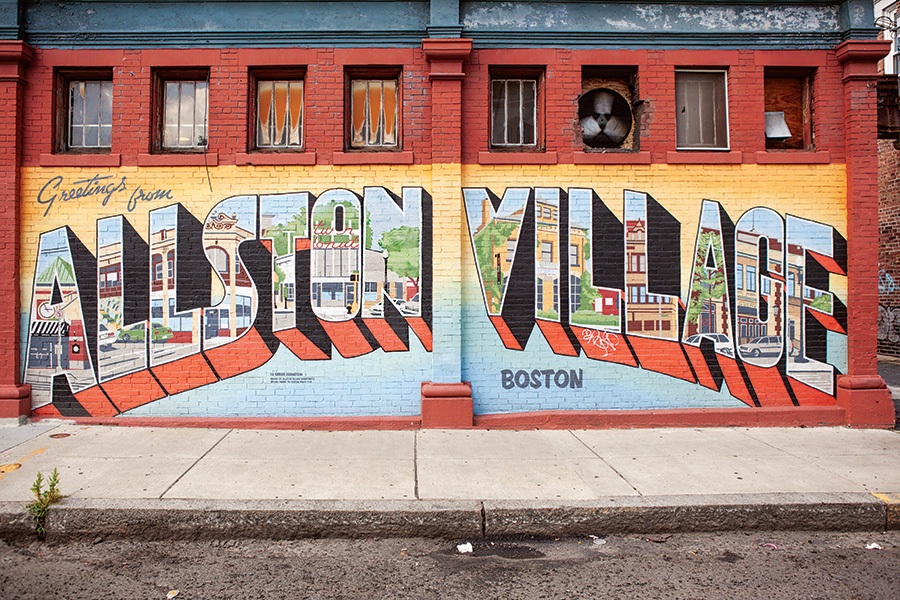
The iconic Greetings from Allston mural on Farrington Ave. / Photo by Mona Miri
Stroll down Harvard Avenue in Allston on a Saturday night, and the immediate barrage of sights, sounds, and tastes makes clear you’ve entered Boston’s one true bohemia. Concert fliers festoon telephone poles, the smell of fried chicken and bulgogi wafts out of Korean joints, and flannel—boy howdy, is there a lot of flannel. As the hour grows later, you’ll spot punks queuing outside Brighton Music Hall and rowdy undergrads spilling out of the slanting door frame of some neglected rowhouse. Take a turn into a back alley and—yikes!—there are enough rats swarming around the garbage cans to make you recall your most recent inoculation. As Bostonians elsewhere settle onto a stool at their neighborhood’s newest wine bar to sip malbec, Allston remains the domain of those who would prefer to gobble noodles out of a Styrofoam clamshell while bass rattles through their headphones.
At least for now, anyway. Far away from the clamor, plans are being drawn up to close the gap between Allston Rock City and the rest of Boston. Later this year, Harvard will unveil the first inkling of its vision for a new Lower Allston, a handful of buildings designed to recast acres of bare earth into a “work, live, play, 24/7 active community.” At least, that’s how Thomas Glynn, the head of the freshly formed Harvard Allston Land Company, explains it. On this muggy July day, he’s meeting with me in a tasteful conference room perched high above Harvard Square to outline the university’s ambitious plans for developing the 130-plus acres it owns between Western Avenue and Boston University. Slender and tieless, with nearly imperceptible spectacles, Glynn exudes a casual comfort with the task, and for good reason: Until last fall, he was the CEO of Massport, where he’d landed after successful terms at the helm of the MBTA and Partners HealthCare. Together with Mark Handley, the university’s point man for community and governmental outreach on the other side of the Charles, he walks me through the coming transformation.
The changes, Glynn says, have been a long time coming. They’ll begin with the land just south of Western Avenue and will eventually extend all the way to the former CSX rail yard—a desolate smear along the Charles, bisected by the Mass. Pike, that dominated Lower Allston for generations. Harvard quietly acquired the land between its tony business school and that rail yard toward the end of the 20th century as the heavy industries that had previously operated there fell into protracted decline, and finally capped off the buying spree with a deal struck in 2009 to take over the rail yard itself. Since then, the school has been formulating a plan for filling the now yawning gap with an entirely new neighborhood that will connect the university’s institutional footprint to the north (the business school, the football stadium, and a brand-new engineering center slated to open next year) with the tightly packed houses to the south that pulse with music on weekends.
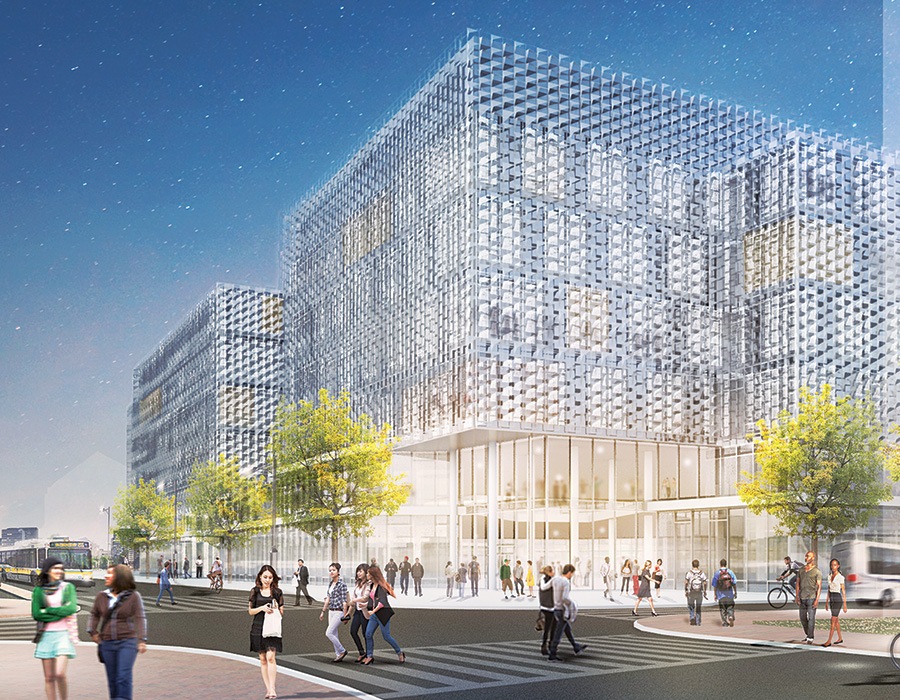
A rendering of Harvard’s Science and Engineering Complex on Western Ave.
The first step in that plan is the construction of what Harvard is calling the Enterprise Research Campus: four buildings totaling close to a million square feet that will include a hotel, housing, and commercial offices, as well as a sizable swath of green space. But that’s just the beginning: After those initial four buildings, Harvard will build out an additional 22 acres, followed by 90 more acres that will be freed up once the much-ballyhooed Mass. Pike realignment project wraps up a decade from now.
The goal, Glynn says, is to inject “some of the private-sector energy that we see in Kendall and, to a certain extent, in the Seaport” while at the same time creating “a place that people in Allston are welcome at and feel proud of.” He allows a small smile, as if admitting that those two ideas aren’t always compatible. “Everybody we’ve talked to says [that] this stuff is hard to figure out. Don’t assume every single thing is going to go exactly the way…” he trails off. “You have to maintain some ability to maneuver. Because things change.”
Harvard may be leading the charge in Lower Allston, but after years of escaping the construction boom that’s remaking Boston into a city of gleaming towers and upscale condos, our college ghetto is suddenly on every other builder’s mind, too. At least 800,000 square feet of private development unrelated to Harvard is either currently under construction or has been approved by the Boston Planning & Development Agency (BPDA), with close to an additional 2 million square feet under review—taken together, that’s the equivalent of 200 Clarendon (the former John Hancock Tower) and the Millennium Tower combined, all likely to be sprinkled across the neighborhood over the course of the next decade.
None of this is necessarily bad—many Allstonians welcome the promise of renewal that comes with such interest. Horror stories about apartments that haven’t been up to code since the ’70s abound, and frustration with traffic and the Green Line’s lackadaisical performance has never been higher. At the same time, others worry that between Harvard’s plans and those of private developers, a tide is rising that could sweep away the neighborhood’s long-cherished identity as a cheap harbor for artists, musicians, students, and working families, replacing relatively affordable rents with luxe condos.
To further complicate matters, the vagueness of Harvard’s plans has sent shivers of anxiety through the community. The Enterprise Research Campus will have four buildings, sure, but the university intends to task a private developer with putting forward a concrete proposal, meaning details about what those buildings will look like and how they’ll relate to the rest of Western Avenue are still a long way from becoming public. “The community is being asked to take a huge leap of faith,” says Anthony D’Isidoro, a local activist and the head of the Allston Civic Association. He and other longtime residents say they’re struggling to comprehend how all of these nice new buildings’ white-collar tenants will fit into a neighborhood they might otherwise shun as a vortex of hipsterdom and dreadlocked college students. And whether at community meetings, neighborhood bars, or band-practice spaces, they haven’t been afraid to ask this question: Is Harvard about to overrun bohemian Allston? Or will it find a way to integrate one of Boston’s most enigmatic neighborhoods into the thriving city that surrounds it?
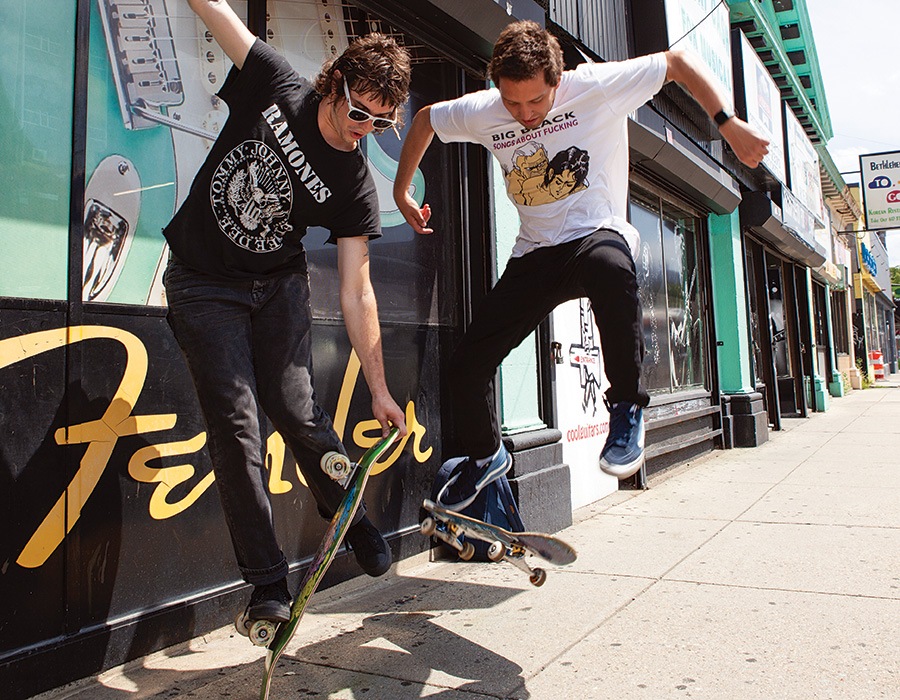
Views from Harvard Ave. and Western Ave. include skateboarders outside of Mr. Music. / Photo by Mona Miri
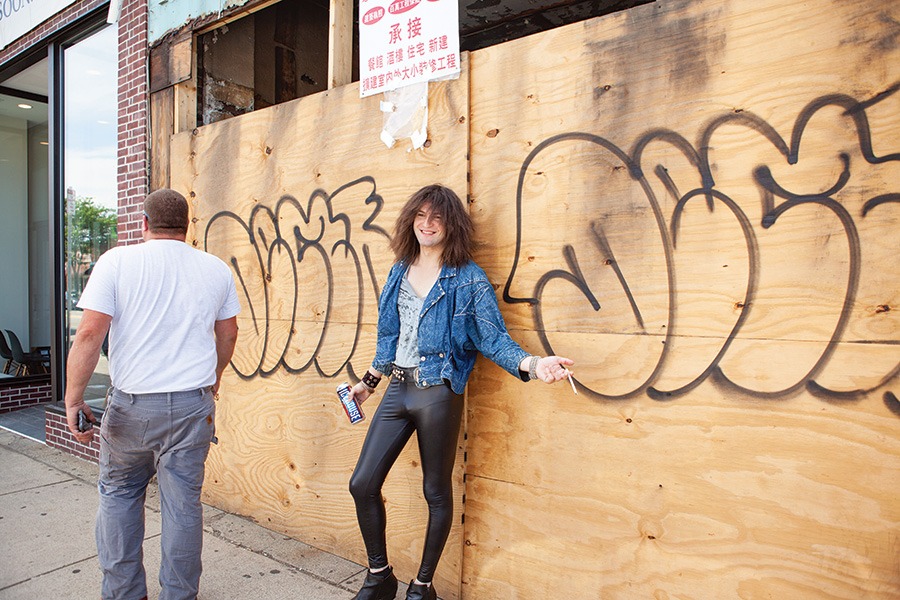
Views from Harvard Ave. and Western Ave. include models on a shoot. / Photo by Mona Miri
Contrary to its reputation, there’s more to Allston than the Rock City stereotypes associated with the yearly tides of dewy-eyed tenants searching for their big break. Despite having the city’s third-largest total student population after Mission Hill and the Fenway/Kenmore area, only around 20 percent of Allston residents are students—hardly an overwhelming number. The rest of the neighborhood is made up of lifers like D’Isidoro, young adults—78 percent of the neighborhood is between 18 and 34—and a growing population of those claiming Chinese, Korean, South Asian, and Vietnamese heritage. In all, one-third of Allston is nonwhite. In a city often dinged for its segregated neighborhoods, Allston is a bustling microcosm of what the rest of Boston can be.
It’s that identity that drew Wenting Ye to Allston after she decided to leave her job in finance to open a bubble-tea shop. Her store, TeaMoji, sits across Union Square from Twin Donuts—a natural choice, Ye says, given what she calls the surrounding area’s “international” feel. While TeaMoji faces stiff competition from Kung Fu Tea and Gong Cha, international chains with locations on Harvard Avenue, Ye thinks her shop has a particular appeal to Allstonians. “Allston is a multicultural area,” she says. “People are welcoming new stuff instead of repetitive chain stores that don’t have too much character.”
Indeed, character is something Allston has never been short on. With Berklee dropouts and MassArt night students perpetually lured by the affordable rents, it’s impossible to walk two blocks without admiring some abstract mural, finding yourself weirdly drawn in by a flier for “an interactive group ritual/performance workshop for storytelling through gesture,” or hearing a wistful saxophone tune billowing out the window of a Comm. Ave. walkup. Music, especially, “has always been central to Allston’s identity,” says Mark Ciommo, the neighborhood’s city councilor. “I’ve lived here for 62 years, and I grew up listening to Aerosmith in Union Square and the Doors at Rena Park. It’s our brand.” Though plenty of neighborhoods in Boston can boast some facet of what makes Allston special—affordability, diversity, a density of artists—the particular mix here is unique and contributes to the feeling that Allston’s wavelength is just a few ticks off from the rest of the city’s.
Harvard’s presence has long been integral to the neighborhood’s identity, too. The university has had a foothold in Allston since it built its football stadium there in 1903, and over the course of the 20th century its presence gradually grew to include most of its athletic facilities and the business school. That expansion ramped up significantly in the ’80s and ’90s, when Harvard quietly bought up the land it is now poised to develop. When those acquisitions were made public in 1997, then-Mayor Tom Menino channeled the shock of many residents when he fumed that the university’s choice to disguise its identity to avoid paying a premium over what a private company might spend represented “the highest level of arrogance seen in our city in many years.”
Feelings in the community remain raw over Harvard’s conduct at the time. Drew Gilpin Faust, who was the university’s president until last year, put in “a lot of effort to rebuild trust in the neighborhood,” Councilor Ciommo says. But the distrust persists, as evidenced by Harvard’s March 2018 presentation at the BPDA, during which several residents objected to the school’s plans for the Enterprise Research Campus on the grounds that no firm commitments had been made to ensure affordability, transit access, or continuity with the neighborhood’s architectural character.

Tom Glynn / Photo by Essdras M. Suarez / The Boston Globe via Getty Images
This is where Glynn, who readily acknowledges the need to overcome the “tensions that came out of the [land] purchases,” comes in. Put simply, his job is to make as many people as possible happy while getting this thing built—and he’s well aware that there’s still plenty of work to be done when it comes to convincing the community that Harvard’s vision for Allston will be beneficial to the folks already living there. “The public-realm component of this is very, very important,” he explains during our meeting. “You really have to work and have a consensus.” In fact, the whole project, Glynn says, is being designed with the community in mind. To illustrate this, he points to the ribbon of parkland that will eventually be created by the Enterprise Research Campus, effectively extending Rena Park to within a stone’s throw of the Charles. “We’re not just interested in building,” he tells me. “We want to create a destination.”
To get a sense of how feasible this might be, I spoke with urban designer Mary Anne Ocampo, a principal at Watertown’s Sasaki who also teaches at MIT. While Ocampo said that new green space can certainly give longtime residents a reason to visit a development, she also pointed to the importance of investing in what she calls “physical seams”: the streets that divide such projects from their surroundings. In her work, Ocampo encourages clients not to see such streets as boundaries, but as “zippers, and we want to zip the new development together with what’s on the other side to create a place where you want to be, not just that you pass through.” That typically means building retail outlets and coffee shops, but it can also include investing in art galleries, performance venues, and community spaces where residents might be able to take a class or attend a lecture. Harvard is in the process of selecting a developer for the Enterprise Research Campus, a decision that will likely be announced later this year. Once that happens, it will be up to that developer to create the integrating features Ocampo describes—or risk designing a collection of buildings that instead turns a cold shoulder to Allston’s signature low-slung houses across the way.
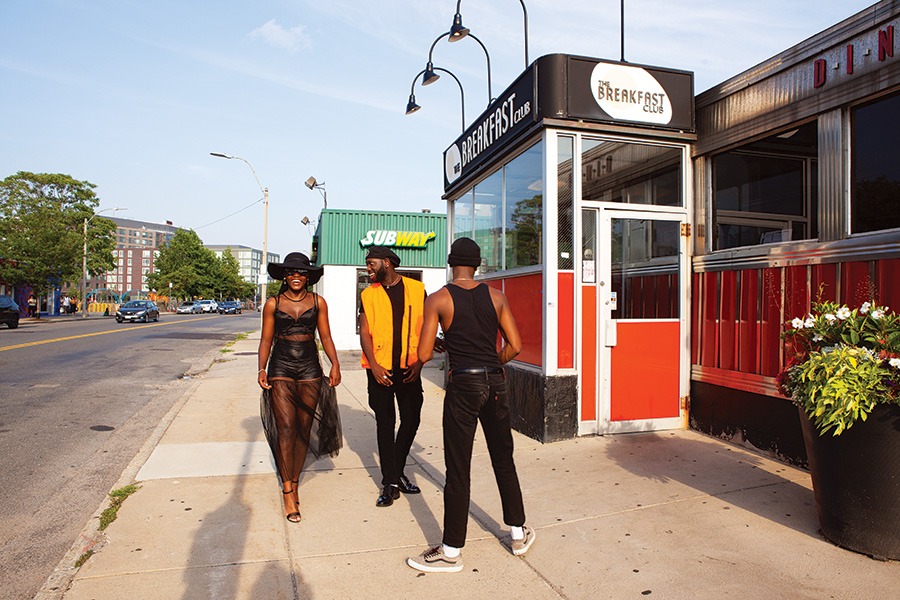
Views from Harvard Ave. and Western Ave. include models on a shoot. / Photo by Mona Miri

Views from Harvard Ave. and Western Ave. include musicians and public art. / Photo by Mona Miri
I meet up with brothers Harry and Mike O’Toole—two-thirds of the indie-rock trio Today Junior—at their practice space in the Allston-Brighton borderlands. It’s difficult to determine how much practicing has really been going on, though, as Mike ushers me through a labyrinth of corridors in an old, industrial-feeling building off Brighton Avenue and into their chamber, where Harry has a VHS of Terminator 2 fired up on a home entertainment system that would’ve turned heads in 1994. The walls are decked out in the band’s old show posters and art featuring Jimi Hendrix, the Misfits, and Super Mario Bros. 3, all lit up by a spangle of Christmas lights.
Once Harry has had a chance to make a quick run out to the bodega for a six-pack of Coronas, we get down to business: talking about how the music scene has changed over the eight or so years they’ve been playing around Allston. As things stand now, Harry says, if you’re looking for local music, “There’s either the bars, there’s the house shows, or there might be a restaurant, or a vintage shop turned into a venue.” Among these, house shows are the most popular, something he thinks will continue “as long as there are those houses in the Lower Allston area, the Allston Rat City, as I like to refer to it.” That means the bulky apartment and office buildings that seem likely to emerge on Harvard’s Enterprise Research Campus aren’t exactly welcome. “When you have all those high-rise condominiums,” Mike says, “you start to lose some of that grungy culture that makes this a—dare I say—hipster area. It sort of creates a new way of life for the city.”
There’s more at stake than just culture, though. “Displacement, gentrification are real things,” D’Isidoro, the community activist, tells me over coffee at the Swissbäkers in Barry’s Corner, near Harvard’s new engineering building on Western Avenue. “Projects come in, longtime residents are displaced, and what goes in is a whole lot more expensive than what was there.”
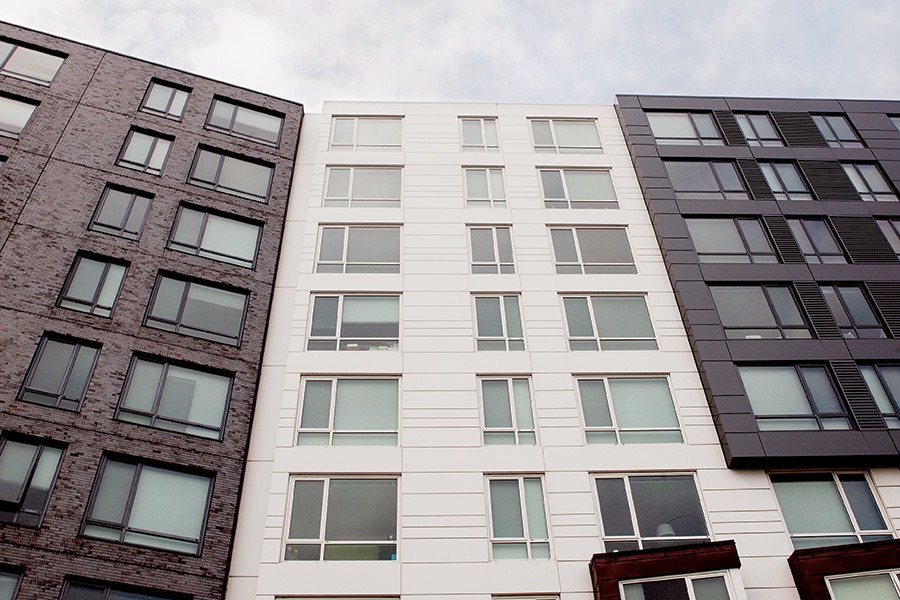
A view of the Continuum buildings. / Photo by Mona Miri
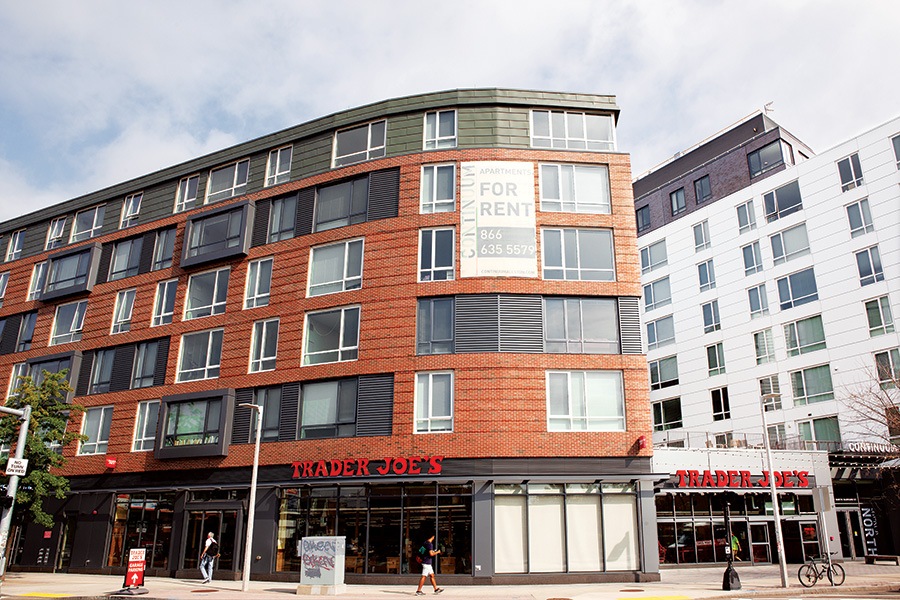
A view of the Continuum buildings. / Photo by Mona Miri
To make his point, he gestures out the window at Continuum, a mixed-use complex already built by Samuels & Associates on a Harvard ground lease (meaning that Harvard owns the land Continuum sits on, but not the buildings). Two-bedroom units at Continuum cost upward of $4,000 per month, double the neighborhood average. In a statement, Leslie Cohen, the COO at Samuels who led the project, noted that the amenities at Continuum were a direct response to local residents’ feedback that “prioritized community gathering places, greater connectivity to Smith Field, improved environment for pedestrians and bikers, and a grocery store.” But D’Isidoro, at least, doesn’t view the attempt to connect the development’s pair of mid-rise towers to the rest of Lower Allston as a success and fears more of the same with Harvard’s development. “I’m very supportive of building a new Allston and Brighton for the next generation and generations to come,” D’Isidoro explains. “But it’s gotta be done right.”
D’Isidoro says he’s particularly bothered by Harvard’s unwillingness to make any specific commitments about affordable housing ahead of the city’s approval of the broad project outlines at that March 2018 BPDA meeting, and worries that the university’s choice to lease its land to a private developer will translate into a lack of accountability for whatever eventually does get built. “What normally happens is it’s a fait accompli,” he says. “They’ll go out and develop all of their plans, announce all their intentions, and then they ask the community to approve it.”
Harvard officials told me that’s not entirely wrong: The university doesn’t intend to seek input from residents during the developer selection process, and the Impact Advisory Group (of which D’Isidoro is a member) that weighed in on the basic scope of the Enterprise Research Campus won’t have another chance to comment until a firm proposal has been drawn up. Still, Glynn was quick to point out how the community’s input is already shaping the Enterprise Research Campus, namely its desire for plenty of open space and a variety of amenities. As far as transportation goes, Harvard has also pledged to kick in $58 million for the forthcoming West Station, a commuter-rail stop meant to provide those living in Lower Allston and at the western edge of BU with a quick ride into South Station.
Even with all of the community perks, D’Isidoro remains concerned about what the school’s development may do to exacerbate the transient identity of a neighborhood where just 11 percent of housing is owner-occupied. The ground lease system Harvard used at Continuum and plans for the Enterprise Research Campus typically makes it difficult to finance building more than a token number of residences that average Allstonians could afford to buy. “You can’t do home ownership,” D’Isidoro steams. “You can’t do condominiums on a leased property.”
In addition to the housing issues, Mike O’Toole is wary of how new apartment buildings will change the small-business-friendly landscape of the neighborhood, saying, “You can’t walk down a street from a bar and then hit up Amelia’s Taqueria if all the buildings are just high-rises, and all the bottom floors are super sterile.” Indeed, spend five minutes searching for a cup of coffee in the Seaport, and it quickly becomes obvious that massive developments are breeding grounds for chain brands rather than local spots like TeaMoji. In such areas, Ocampo says, the streetscape becomes “more fragmented,” as each building competes for attention rather than complements its surroundings.
Harvard, then, is facing a mammoth list of resident priorities for the Enterprise Research Campus and the rest of its holdings in Lower Allston, among them preserving affordability, carving out space for musicians and artists, giving local businesses the opportunity to compete, and allowing for an organic transition between old and new. Glynn is confident he can achieve all of this, but as he succinctly puts it, “With all these things, the proof in the pudding is in the eating.”
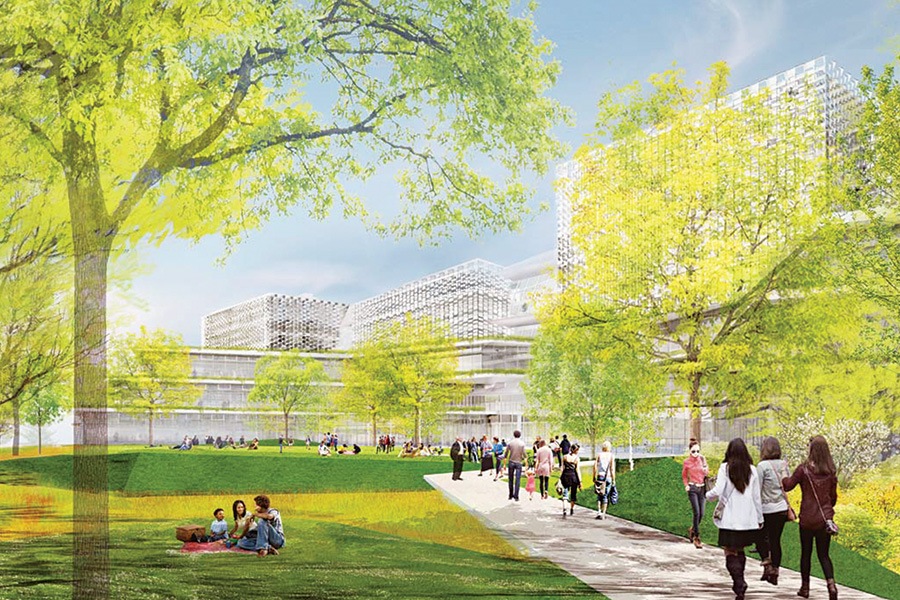
A rendering of the Science and Engineering Complex.
Despite the shroud of mystery over what might happen in Allston, there’s already a model of one possible future just across the river in Kendall Square. There, MIT is constructing an office building housing Boeing, Apple, and Capital One that’s slated to stand shoulder to shoulder with a new high-rise dormitory. It’s a comparison Glynn welcomes, telling me Harvard hopes that the Enterprise Research Campus’s positioning adjacent to the business and engineering schools will create what he calls “synergistic opportunities for students, faculty, and staff with the commercial world,” not to mention an infusion of jobs and tax revenue for the neighborhood. Of course, once phrases like “synergistic opportunities” start getting thrown around, it becomes clear why activists such as D’Isidoro are so apprehensive—though the benefits Harvard will reap are clear, they aren’t as obvious for longtime residents.
It’s a problem that a number of recent neighborhood additions have tackled by channeling Lower Allston’s creative side, many with tremendous success. The Aeronaut beer garden, which first opened in 2016, has swiftly become a beloved warm-weather watering hole thanks to its regular concerts. And Harvard’s so-called Zone 3 initiative “to further activate and energize Western Ave.” has been well received, particularly its Art in Print project, which over the past two years has commissioned 30 visual artists to design posters that can be purchased for a quarter out of repurposed newspaper boxes.
No new development, though, has leaned into the neighborhood’s artistic identity quite as emphatically as the Davis Companies’ Studio Allston Hotel. On a tour with manager Arnaldo Almonte, I learn that not only were local artists hired to decorate every room, but the hotel is also constantly looking for new opportunities to reengage them. Almonte bubbles over with ideas on how the hotel’s under-utilized spaces could be filled with art and other programming: He’d love to invite a tattoo artist to set up shop in a space just off the main entrance, maybe have the kids from the nonprofit Cradles to Crayons paint a mural in a hallway, and even stage a concert in a chandelier-lit conference room whose walls have been tiled with secondhand mirrors. “We’ll put in some nice up-lights, we’ll get some great sound going, and it’d be an awesome show,” he says. At the coffee station downstairs, he calls my attention to an unappealing conduit pipe on the wall and tells me he’s working with one artist to design an installation that will “celebrate the pipe” by surrounding it with more conduit contorted into a “cool, interesting pattern.”
We finish up on the sun-soaked patio, a bustling space that staffers from the hotel’s restaurant, Casa Caña, are setting up for a summer pig roast. As servers and guests buzz around, the musical entertainment arrives, featuring a woman rocking a leopard-print jumpsuit and a guy strutting in harem pants, loafers, and a bowler hat. For his part, Almonte hardly sees a contradiction between Studio Allston’s funky vibe and Harvard’s expansion, casting both as continuations of “this blossoming of the community.” Eschewing its buttoned-up image, the university even bought out the premises for a business school alumni function earlier this year. A class of HBS Masters of the Universe networking in a hotel that celebrates conduit pipes? Squint hard, and Allston’s future might already be coming into focus.
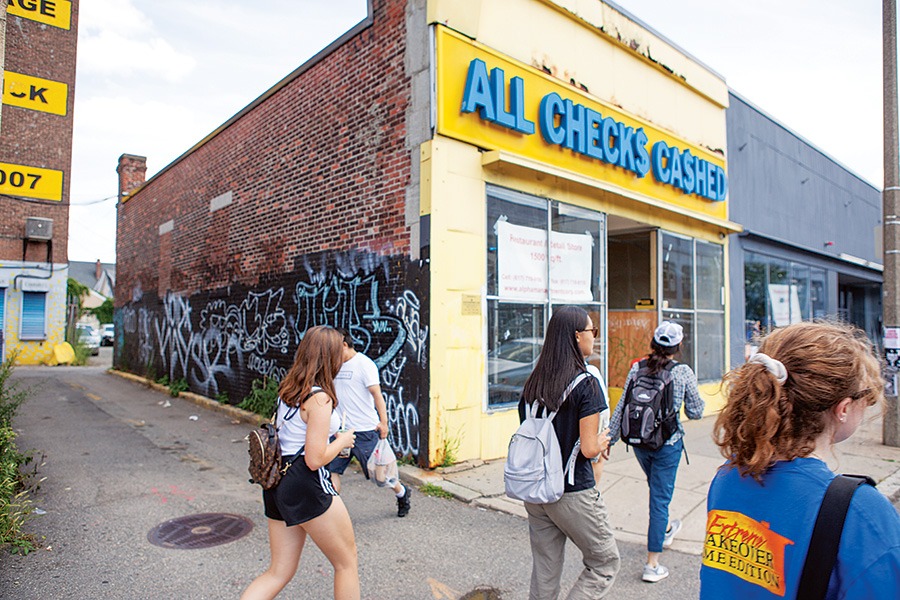
Views from Harvard Ave. and Western Ave. / Photo by Mona Miri
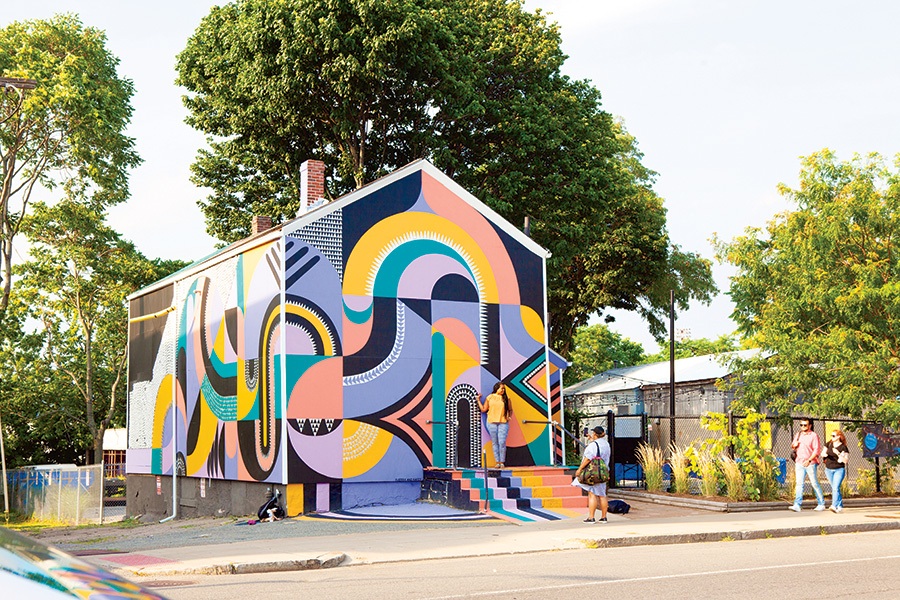
Views from Harvard Ave. and Western Ave. include musicians and public art. / Photo by Mona Miri
Whatever that future holds seems a long way off when I meet Alex Orfanos for a drink at the Hopewell on Comm. Ave. Orfanos, who works for a tech startup in the Seaport, spent two years in Packard’s Corner as a BU student and stayed close by after graduating in 2017. Over a glass of whiskey, he wistfully reminisces about the “off-campus vibe” of the neighborhood during his college years, when it felt like “there was three degrees of separation between every apartment in Allston. You probably knew someone who took a class with the guy living above you.”
Orfanos cautions me not to get too carried away with conflating the happenings on Western Avenue with changes to the neighborhood as a whole. When “I’m walking down Harvard Avenue by the 7-Eleven, I’m not thinking about gentrification,” he says with a grin. “I’m like, good ol’ Allston.” While he’d hate to see the neighborhood start looking like the Fenway, where “you’ve got four new apartment buildings that cost $5,000 a month for a two-bedroom,” he’s also conscious of the fact that Harvard is hardly tearing down housing for students and the working class. Of the empty swath surrounding the vacant rail yard, he says, “There isn’t anything there. You’re gentrifying an empty lot.”
Even D’Isidoro is hardly all doom and gloom when it comes to anticipating the Allston of tomorrow. “I don’t look backward,” he says. “I don’t want the good old days. I don’t want the old Allston and Brighton.” He sees his role as not forestalling change, but instead pushing developers to help stabilize the neighborhood’s constant ebb and flow of residents by creating more avenues for young people who were initially drawn in by the artistic vibrancy to put down roots there.
At the same time, nobody I spoke with had trouble articulating the features of life in Allston that they feel so passionate about protecting. There’s the kismet of dipping into a bar that feels homier than your living room, or perhaps picking up a food magazine that a new graphic-designer friend mentioned to you at a cookout. Sure, it’s possible such experiences will be gradually edged out by condo superblocks that refigure Allston as just another neighborhood within easy commuting distance of the Financial District. Equally plausible is a future where such generic streetscapes are limited to Harvard and the area around Boston Landing: outposts of the New Boston standing stiffly at the periphery while Allston Rock City keeps jamming.
Most likely, though, the Allston of the future will be something in between. For all the vagueness associated with the Enterprise Research Campus, Harvard’s choice to move methodically, building up its massive holdings in Allston piece by piece rather than all at once, speaks to the university’s ability to remain responsive to the needs of the neighborhood as it transforms over the next decade. “We need to come up with a game plan that’s flexible,” Glynn tells me, “that assumes there will be changes over time and doesn’t put us in a situation where we can’t adapt.”
He’s hardly alone in this strategy: Stephen Davis, the managing director at the Davis Companies who built Studio Allston, applauds such organic growth, saying that building in “smaller bits” forces developers like him to be “more deferential to the existing community.” To preserve Allston’s best qualities—its art, its affordability, its neighborly good humor—such deference will be crucial.
For current Allston residents, too, open-mindedness about what the future holds will be key. Mike O’Toole imagines Harvard building a venue for local artists, or even just townhouses that permit house shows. Arnaldo Almonte sees the university’s expansion as something that “brings new life, new development, new technology— brings folks from all over the world.” In other words, they hope that Allston can be nice without being dull, can be vibrant without being expensive. Once fully built out, Harvard’s 130-plus acres may not look like the Allston that Steven Tyler took by storm in the ’70s. But over time, it’s easy to imagine that its shiny chrome light poles might gradually accrue a couple of layers of weather-beaten masking tape. For Allston to survive, it needs to find a way to grow, change, and become the next version of itself. Achieving that goal won’t be easy, but there’s just as much reason for hope as there is for fear. Throw on the right flannel, and anything’s possible.
Note: In “It’s the End of Allston As We Know It” [September], the architectural renderings should be identified as Harvard’s upcoming Science and Engineering Complex, not its Enterprise Research Campus.


